Management and Organizations in a Global Environment: Cognitive Biases
VerifiedAdded on 2020/04/07
|19
|5649
|41
Report
AI Summary
This report delves into the influence of cognitive biases on managerial decision-making within a global environment. It begins with an executive summary and an introduction to the concept of cognitive biases, emphasizing their impact on the quality of decisions. The report highlights ten specific cognitive biases, selected from a broader list, and provides detailed explanations, real-life examples, and the challenges businesses face due to these biases. The analysis covers biases such as attenuation bias, framing bias, confirmation bias, and overconfidence bias, illustrating how they distort the decision-making process and lead to errors. The report concludes with an analysis of the insights gained from studying these biases, offering a comprehensive understanding of their effects on organizational outcomes and providing valuable information for students on Desklib.
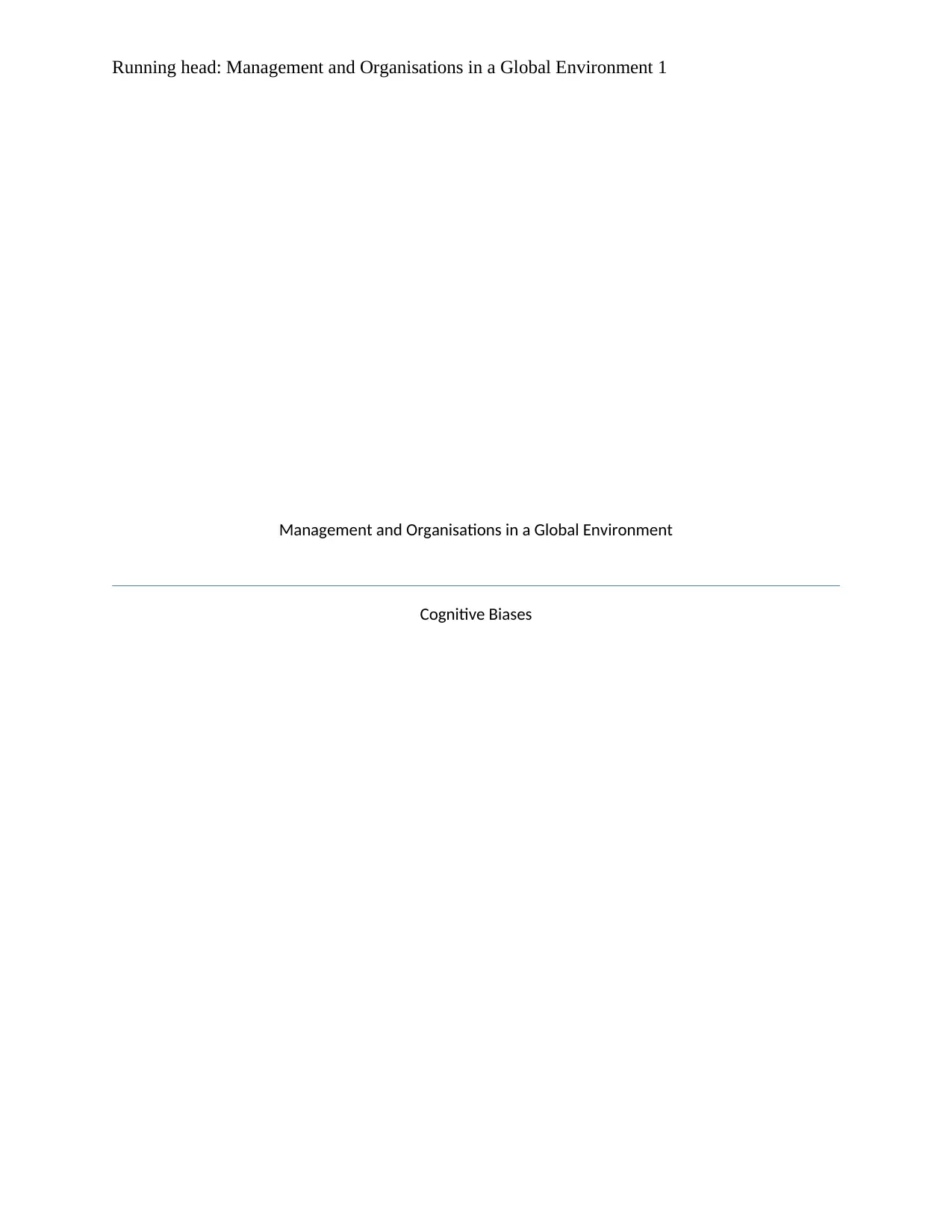
Running head: Management and Organisations in a Global Environment 1
Management and Organisations in a Global Environment
Cognitive Biases
Management and Organisations in a Global Environment
Cognitive Biases
Paraphrase This Document
Need a fresh take? Get an instant paraphrase of this document with our AI Paraphraser
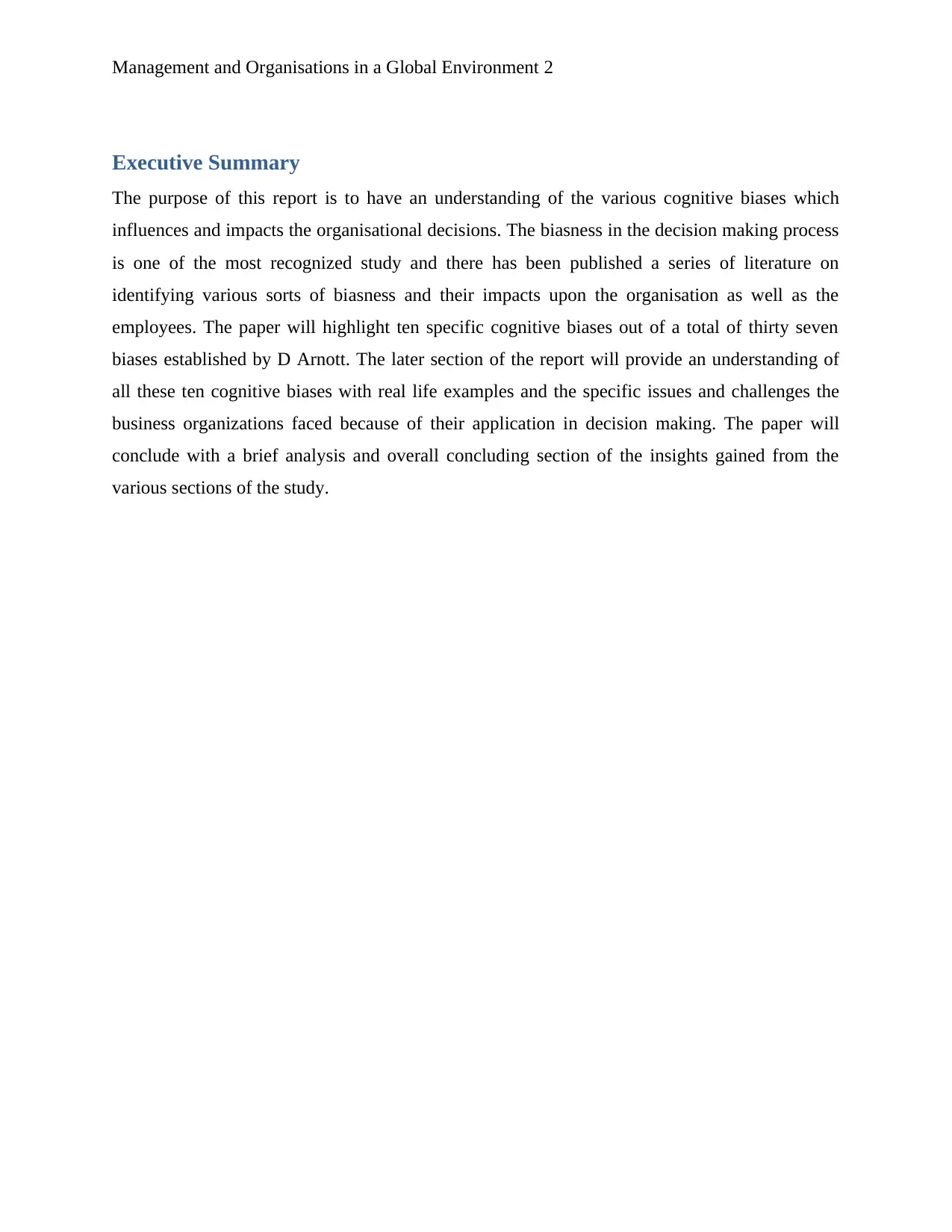
Management and Organisations in a Global Environment 2
Executive Summary
The purpose of this report is to have an understanding of the various cognitive biases which
influences and impacts the organisational decisions. The biasness in the decision making process
is one of the most recognized study and there has been published a series of literature on
identifying various sorts of biasness and their impacts upon the organisation as well as the
employees. The paper will highlight ten specific cognitive biases out of a total of thirty seven
biases established by D Arnott. The later section of the report will provide an understanding of
all these ten cognitive biases with real life examples and the specific issues and challenges the
business organizations faced because of their application in decision making. The paper will
conclude with a brief analysis and overall concluding section of the insights gained from the
various sections of the study.
Executive Summary
The purpose of this report is to have an understanding of the various cognitive biases which
influences and impacts the organisational decisions. The biasness in the decision making process
is one of the most recognized study and there has been published a series of literature on
identifying various sorts of biasness and their impacts upon the organisation as well as the
employees. The paper will highlight ten specific cognitive biases out of a total of thirty seven
biases established by D Arnott. The later section of the report will provide an understanding of
all these ten cognitive biases with real life examples and the specific issues and challenges the
business organizations faced because of their application in decision making. The paper will
conclude with a brief analysis and overall concluding section of the insights gained from the
various sections of the study.
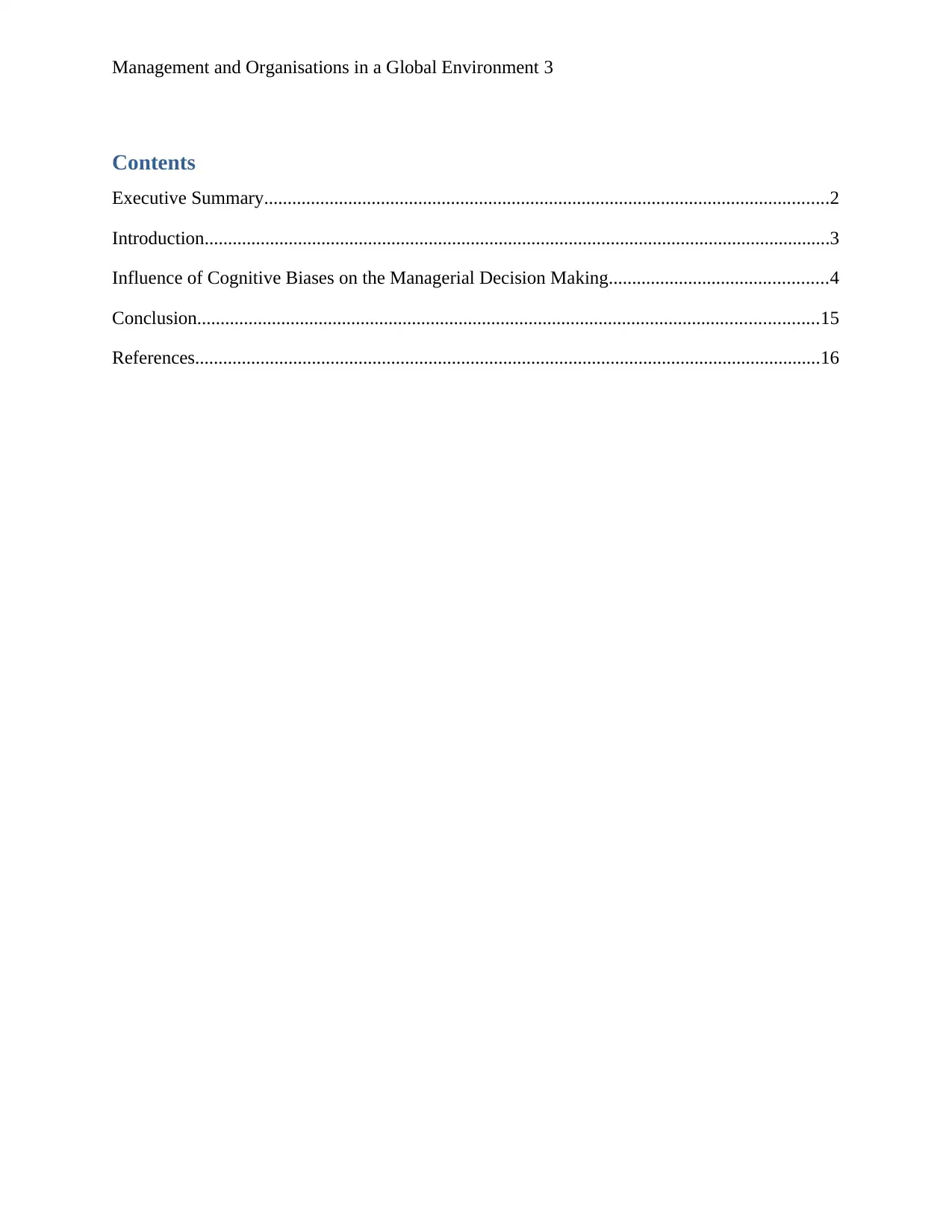
Management and Organisations in a Global Environment 3
Contents
Executive Summary.........................................................................................................................2
Introduction......................................................................................................................................3
Influence of Cognitive Biases on the Managerial Decision Making...............................................4
Conclusion.....................................................................................................................................15
References......................................................................................................................................16
Contents
Executive Summary.........................................................................................................................2
Introduction......................................................................................................................................3
Influence of Cognitive Biases on the Managerial Decision Making...............................................4
Conclusion.....................................................................................................................................15
References......................................................................................................................................16
⊘ This is a preview!⊘
Do you want full access?
Subscribe today to unlock all pages.

Trusted by 1+ million students worldwide
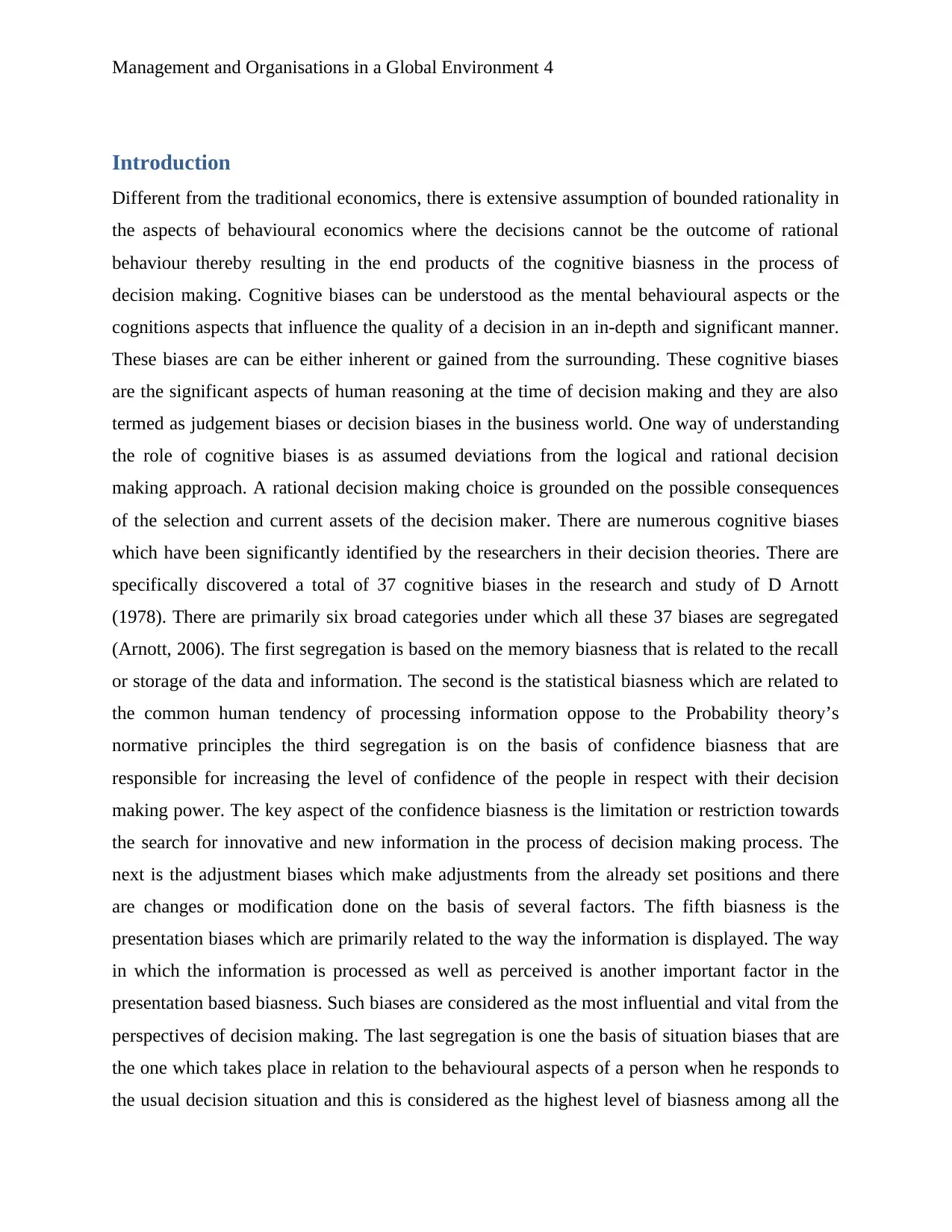
Management and Organisations in a Global Environment 4
Introduction
Different from the traditional economics, there is extensive assumption of bounded rationality in
the aspects of behavioural economics where the decisions cannot be the outcome of rational
behaviour thereby resulting in the end products of the cognitive biasness in the process of
decision making. Cognitive biases can be understood as the mental behavioural aspects or the
cognitions aspects that influence the quality of a decision in an in-depth and significant manner.
These biases are can be either inherent or gained from the surrounding. These cognitive biases
are the significant aspects of human reasoning at the time of decision making and they are also
termed as judgement biases or decision biases in the business world. One way of understanding
the role of cognitive biases is as assumed deviations from the logical and rational decision
making approach. A rational decision making choice is grounded on the possible consequences
of the selection and current assets of the decision maker. There are numerous cognitive biases
which have been significantly identified by the researchers in their decision theories. There are
specifically discovered a total of 37 cognitive biases in the research and study of D Arnott
(1978). There are primarily six broad categories under which all these 37 biases are segregated
(Arnott, 2006). The first segregation is based on the memory biasness that is related to the recall
or storage of the data and information. The second is the statistical biasness which are related to
the common human tendency of processing information oppose to the Probability theory’s
normative principles the third segregation is on the basis of confidence biasness that are
responsible for increasing the level of confidence of the people in respect with their decision
making power. The key aspect of the confidence biasness is the limitation or restriction towards
the search for innovative and new information in the process of decision making process. The
next is the adjustment biases which make adjustments from the already set positions and there
are changes or modification done on the basis of several factors. The fifth biasness is the
presentation biases which are primarily related to the way the information is displayed. The way
in which the information is processed as well as perceived is another important factor in the
presentation based biasness. Such biases are considered as the most influential and vital from the
perspectives of decision making. The last segregation is one the basis of situation biases that are
the one which takes place in relation to the behavioural aspects of a person when he responds to
the usual decision situation and this is considered as the highest level of biasness among all the
Introduction
Different from the traditional economics, there is extensive assumption of bounded rationality in
the aspects of behavioural economics where the decisions cannot be the outcome of rational
behaviour thereby resulting in the end products of the cognitive biasness in the process of
decision making. Cognitive biases can be understood as the mental behavioural aspects or the
cognitions aspects that influence the quality of a decision in an in-depth and significant manner.
These biases are can be either inherent or gained from the surrounding. These cognitive biases
are the significant aspects of human reasoning at the time of decision making and they are also
termed as judgement biases or decision biases in the business world. One way of understanding
the role of cognitive biases is as assumed deviations from the logical and rational decision
making approach. A rational decision making choice is grounded on the possible consequences
of the selection and current assets of the decision maker. There are numerous cognitive biases
which have been significantly identified by the researchers in their decision theories. There are
specifically discovered a total of 37 cognitive biases in the research and study of D Arnott
(1978). There are primarily six broad categories under which all these 37 biases are segregated
(Arnott, 2006). The first segregation is based on the memory biasness that is related to the recall
or storage of the data and information. The second is the statistical biasness which are related to
the common human tendency of processing information oppose to the Probability theory’s
normative principles the third segregation is on the basis of confidence biasness that are
responsible for increasing the level of confidence of the people in respect with their decision
making power. The key aspect of the confidence biasness is the limitation or restriction towards
the search for innovative and new information in the process of decision making process. The
next is the adjustment biases which make adjustments from the already set positions and there
are changes or modification done on the basis of several factors. The fifth biasness is the
presentation biases which are primarily related to the way the information is displayed. The way
in which the information is processed as well as perceived is another important factor in the
presentation based biasness. Such biases are considered as the most influential and vital from the
perspectives of decision making. The last segregation is one the basis of situation biases that are
the one which takes place in relation to the behavioural aspects of a person when he responds to
the usual decision situation and this is considered as the highest level of biasness among all the
Paraphrase This Document
Need a fresh take? Get an instant paraphrase of this document with our AI Paraphraser
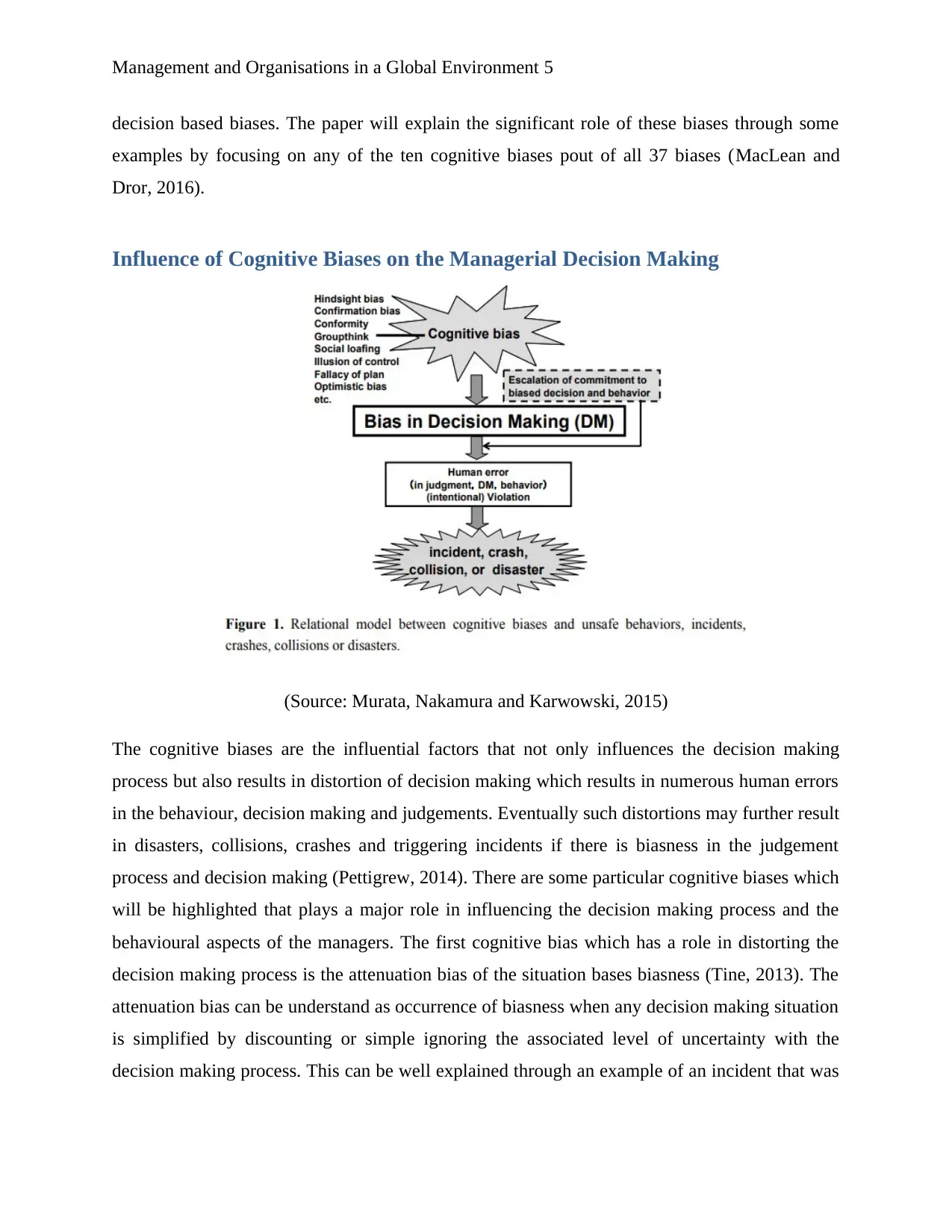
Management and Organisations in a Global Environment 5
decision based biases. The paper will explain the significant role of these biases through some
examples by focusing on any of the ten cognitive biases pout of all 37 biases (MacLean and
Dror, 2016).
Influence of Cognitive Biases on the Managerial Decision Making
(Source: Murata, Nakamura and Karwowski, 2015)
The cognitive biases are the influential factors that not only influences the decision making
process but also results in distortion of decision making which results in numerous human errors
in the behaviour, decision making and judgements. Eventually such distortions may further result
in disasters, collisions, crashes and triggering incidents if there is biasness in the judgement
process and decision making (Pettigrew, 2014). There are some particular cognitive biases which
will be highlighted that plays a major role in influencing the decision making process and the
behavioural aspects of the managers. The first cognitive bias which has a role in distorting the
decision making process is the attenuation bias of the situation bases biasness (Tine, 2013). The
attenuation bias can be understand as occurrence of biasness when any decision making situation
is simplified by discounting or simple ignoring the associated level of uncertainty with the
decision making process. This can be well explained through an example of an incident that was
decision based biases. The paper will explain the significant role of these biases through some
examples by focusing on any of the ten cognitive biases pout of all 37 biases (MacLean and
Dror, 2016).
Influence of Cognitive Biases on the Managerial Decision Making
(Source: Murata, Nakamura and Karwowski, 2015)
The cognitive biases are the influential factors that not only influences the decision making
process but also results in distortion of decision making which results in numerous human errors
in the behaviour, decision making and judgements. Eventually such distortions may further result
in disasters, collisions, crashes and triggering incidents if there is biasness in the judgement
process and decision making (Pettigrew, 2014). There are some particular cognitive biases which
will be highlighted that plays a major role in influencing the decision making process and the
behavioural aspects of the managers. The first cognitive bias which has a role in distorting the
decision making process is the attenuation bias of the situation bases biasness (Tine, 2013). The
attenuation bias can be understand as occurrence of biasness when any decision making situation
is simplified by discounting or simple ignoring the associated level of uncertainty with the
decision making process. This can be well explained through an example of an incident that was
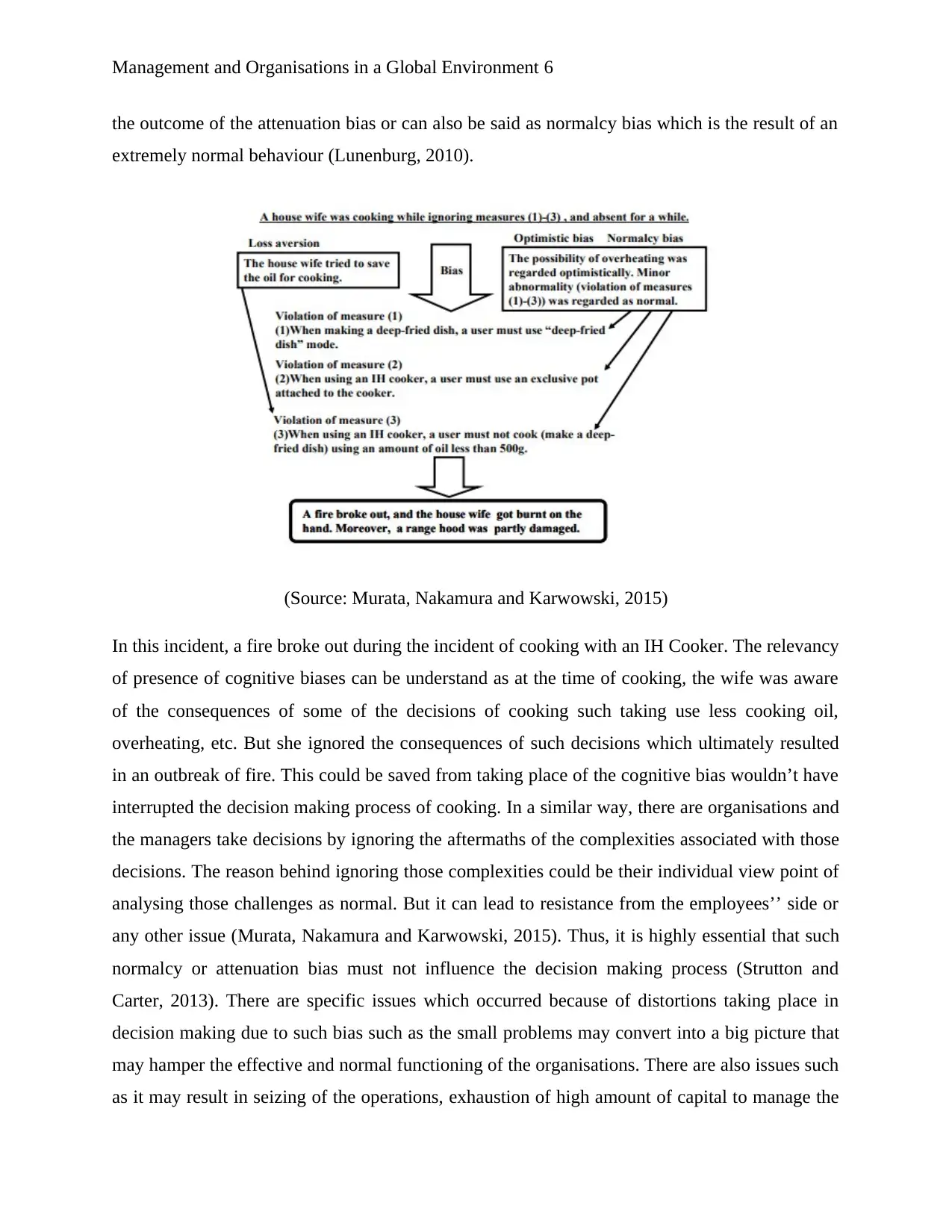
Management and Organisations in a Global Environment 6
the outcome of the attenuation bias or can also be said as normalcy bias which is the result of an
extremely normal behaviour (Lunenburg, 2010).
(Source: Murata, Nakamura and Karwowski, 2015)
In this incident, a fire broke out during the incident of cooking with an IH Cooker. The relevancy
of presence of cognitive biases can be understand as at the time of cooking, the wife was aware
of the consequences of some of the decisions of cooking such taking use less cooking oil,
overheating, etc. But she ignored the consequences of such decisions which ultimately resulted
in an outbreak of fire. This could be saved from taking place of the cognitive bias wouldn’t have
interrupted the decision making process of cooking. In a similar way, there are organisations and
the managers take decisions by ignoring the aftermaths of the complexities associated with those
decisions. The reason behind ignoring those complexities could be their individual view point of
analysing those challenges as normal. But it can lead to resistance from the employees’’ side or
any other issue (Murata, Nakamura and Karwowski, 2015). Thus, it is highly essential that such
normalcy or attenuation bias must not influence the decision making process (Strutton and
Carter, 2013). There are specific issues which occurred because of distortions taking place in
decision making due to such bias such as the small problems may convert into a big picture that
may hamper the effective and normal functioning of the organisations. There are also issues such
as it may result in seizing of the operations, exhaustion of high amount of capital to manage the
the outcome of the attenuation bias or can also be said as normalcy bias which is the result of an
extremely normal behaviour (Lunenburg, 2010).
(Source: Murata, Nakamura and Karwowski, 2015)
In this incident, a fire broke out during the incident of cooking with an IH Cooker. The relevancy
of presence of cognitive biases can be understand as at the time of cooking, the wife was aware
of the consequences of some of the decisions of cooking such taking use less cooking oil,
overheating, etc. But she ignored the consequences of such decisions which ultimately resulted
in an outbreak of fire. This could be saved from taking place of the cognitive bias wouldn’t have
interrupted the decision making process of cooking. In a similar way, there are organisations and
the managers take decisions by ignoring the aftermaths of the complexities associated with those
decisions. The reason behind ignoring those complexities could be their individual view point of
analysing those challenges as normal. But it can lead to resistance from the employees’’ side or
any other issue (Murata, Nakamura and Karwowski, 2015). Thus, it is highly essential that such
normalcy or attenuation bias must not influence the decision making process (Strutton and
Carter, 2013). There are specific issues which occurred because of distortions taking place in
decision making due to such bias such as the small problems may convert into a big picture that
may hamper the effective and normal functioning of the organisations. There are also issues such
as it may result in seizing of the operations, exhaustion of high amount of capital to manage the
⊘ This is a preview!⊘
Do you want full access?
Subscribe today to unlock all pages.

Trusted by 1+ million students worldwide
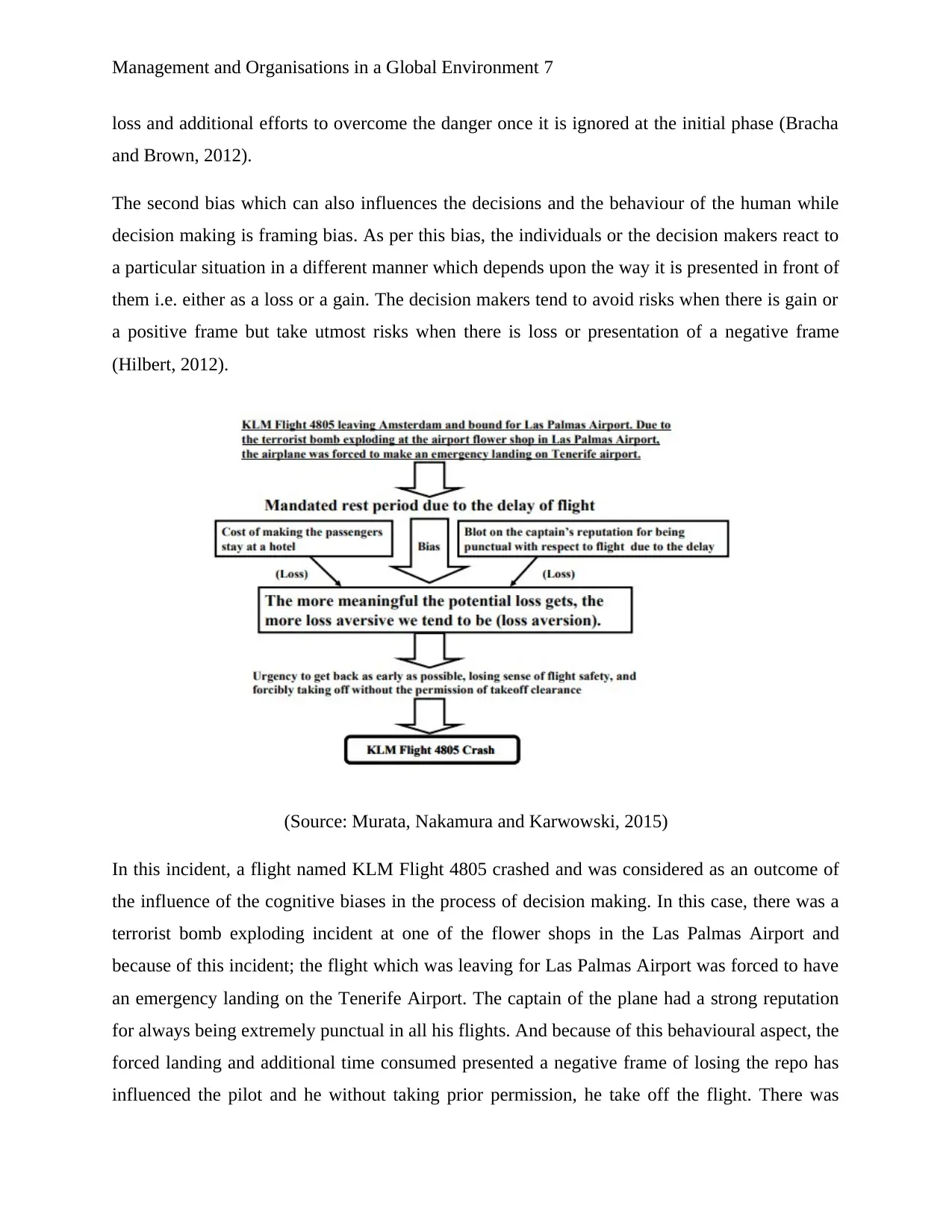
Management and Organisations in a Global Environment 7
loss and additional efforts to overcome the danger once it is ignored at the initial phase (Bracha
and Brown, 2012).
The second bias which can also influences the decisions and the behaviour of the human while
decision making is framing bias. As per this bias, the individuals or the decision makers react to
a particular situation in a different manner which depends upon the way it is presented in front of
them i.e. either as a loss or a gain. The decision makers tend to avoid risks when there is gain or
a positive frame but take utmost risks when there is loss or presentation of a negative frame
(Hilbert, 2012).
(Source: Murata, Nakamura and Karwowski, 2015)
In this incident, a flight named KLM Flight 4805 crashed and was considered as an outcome of
the influence of the cognitive biases in the process of decision making. In this case, there was a
terrorist bomb exploding incident at one of the flower shops in the Las Palmas Airport and
because of this incident; the flight which was leaving for Las Palmas Airport was forced to have
an emergency landing on the Tenerife Airport. The captain of the plane had a strong reputation
for always being extremely punctual in all his flights. And because of this behavioural aspect, the
forced landing and additional time consumed presented a negative frame of losing the repo has
influenced the pilot and he without taking prior permission, he take off the flight. There was
loss and additional efforts to overcome the danger once it is ignored at the initial phase (Bracha
and Brown, 2012).
The second bias which can also influences the decisions and the behaviour of the human while
decision making is framing bias. As per this bias, the individuals or the decision makers react to
a particular situation in a different manner which depends upon the way it is presented in front of
them i.e. either as a loss or a gain. The decision makers tend to avoid risks when there is gain or
a positive frame but take utmost risks when there is loss or presentation of a negative frame
(Hilbert, 2012).
(Source: Murata, Nakamura and Karwowski, 2015)
In this incident, a flight named KLM Flight 4805 crashed and was considered as an outcome of
the influence of the cognitive biases in the process of decision making. In this case, there was a
terrorist bomb exploding incident at one of the flower shops in the Las Palmas Airport and
because of this incident; the flight which was leaving for Las Palmas Airport was forced to have
an emergency landing on the Tenerife Airport. The captain of the plane had a strong reputation
for always being extremely punctual in all his flights. And because of this behavioural aspect, the
forced landing and additional time consumed presented a negative frame of losing the repo has
influenced the pilot and he without taking prior permission, he take off the flight. There was
Paraphrase This Document
Need a fresh take? Get an instant paraphrase of this document with our AI Paraphraser
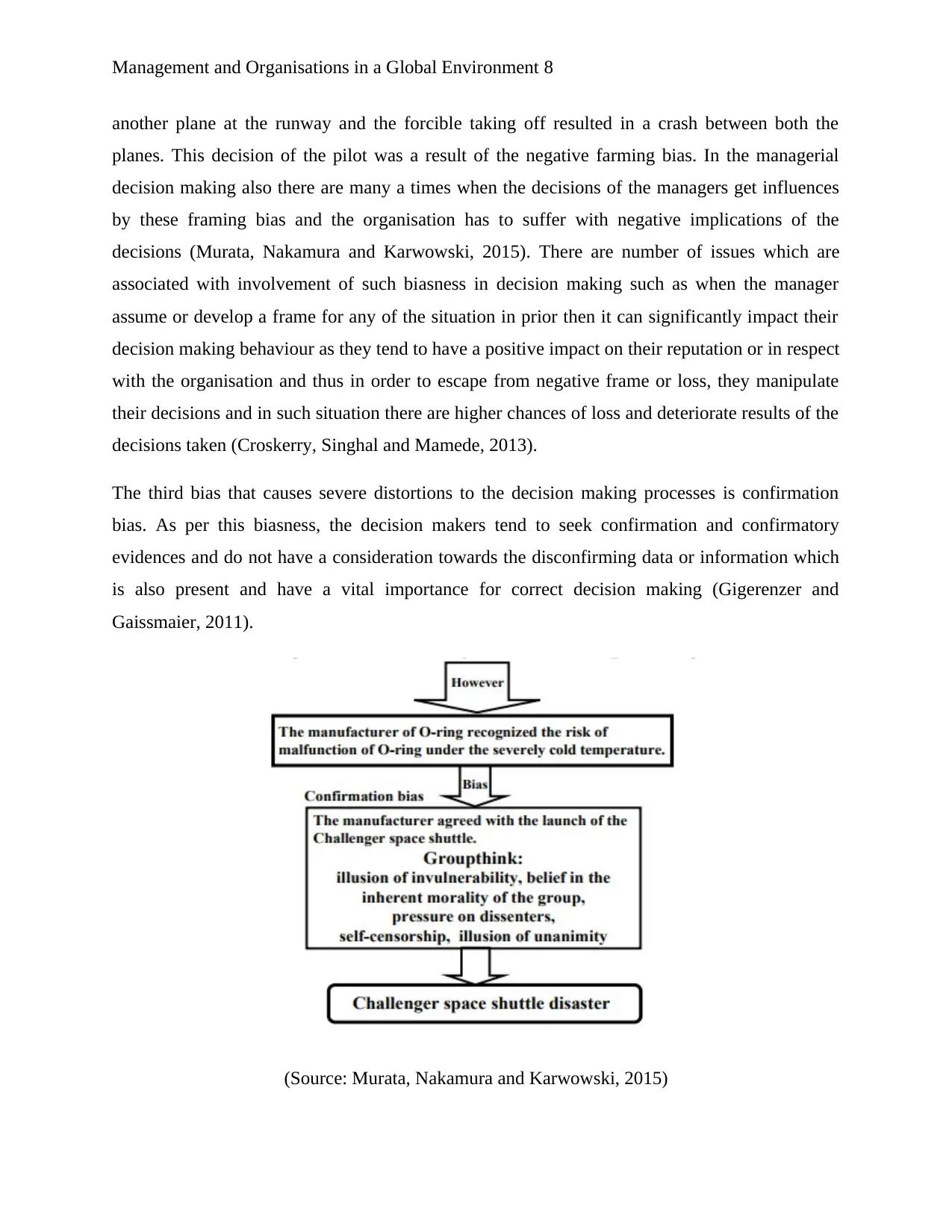
Management and Organisations in a Global Environment 8
another plane at the runway and the forcible taking off resulted in a crash between both the
planes. This decision of the pilot was a result of the negative farming bias. In the managerial
decision making also there are many a times when the decisions of the managers get influences
by these framing bias and the organisation has to suffer with negative implications of the
decisions (Murata, Nakamura and Karwowski, 2015). There are number of issues which are
associated with involvement of such biasness in decision making such as when the manager
assume or develop a frame for any of the situation in prior then it can significantly impact their
decision making behaviour as they tend to have a positive impact on their reputation or in respect
with the organisation and thus in order to escape from negative frame or loss, they manipulate
their decisions and in such situation there are higher chances of loss and deteriorate results of the
decisions taken (Croskerry, Singhal and Mamede, 2013).
The third bias that causes severe distortions to the decision making processes is confirmation
bias. As per this biasness, the decision makers tend to seek confirmation and confirmatory
evidences and do not have a consideration towards the disconfirming data or information which
is also present and have a vital importance for correct decision making (Gigerenzer and
Gaissmaier, 2011).
(Source: Murata, Nakamura and Karwowski, 2015)
another plane at the runway and the forcible taking off resulted in a crash between both the
planes. This decision of the pilot was a result of the negative farming bias. In the managerial
decision making also there are many a times when the decisions of the managers get influences
by these framing bias and the organisation has to suffer with negative implications of the
decisions (Murata, Nakamura and Karwowski, 2015). There are number of issues which are
associated with involvement of such biasness in decision making such as when the manager
assume or develop a frame for any of the situation in prior then it can significantly impact their
decision making behaviour as they tend to have a positive impact on their reputation or in respect
with the organisation and thus in order to escape from negative frame or loss, they manipulate
their decisions and in such situation there are higher chances of loss and deteriorate results of the
decisions taken (Croskerry, Singhal and Mamede, 2013).
The third bias that causes severe distortions to the decision making processes is confirmation
bias. As per this biasness, the decision makers tend to seek confirmation and confirmatory
evidences and do not have a consideration towards the disconfirming data or information which
is also present and have a vital importance for correct decision making (Gigerenzer and
Gaissmaier, 2011).
(Source: Murata, Nakamura and Karwowski, 2015)
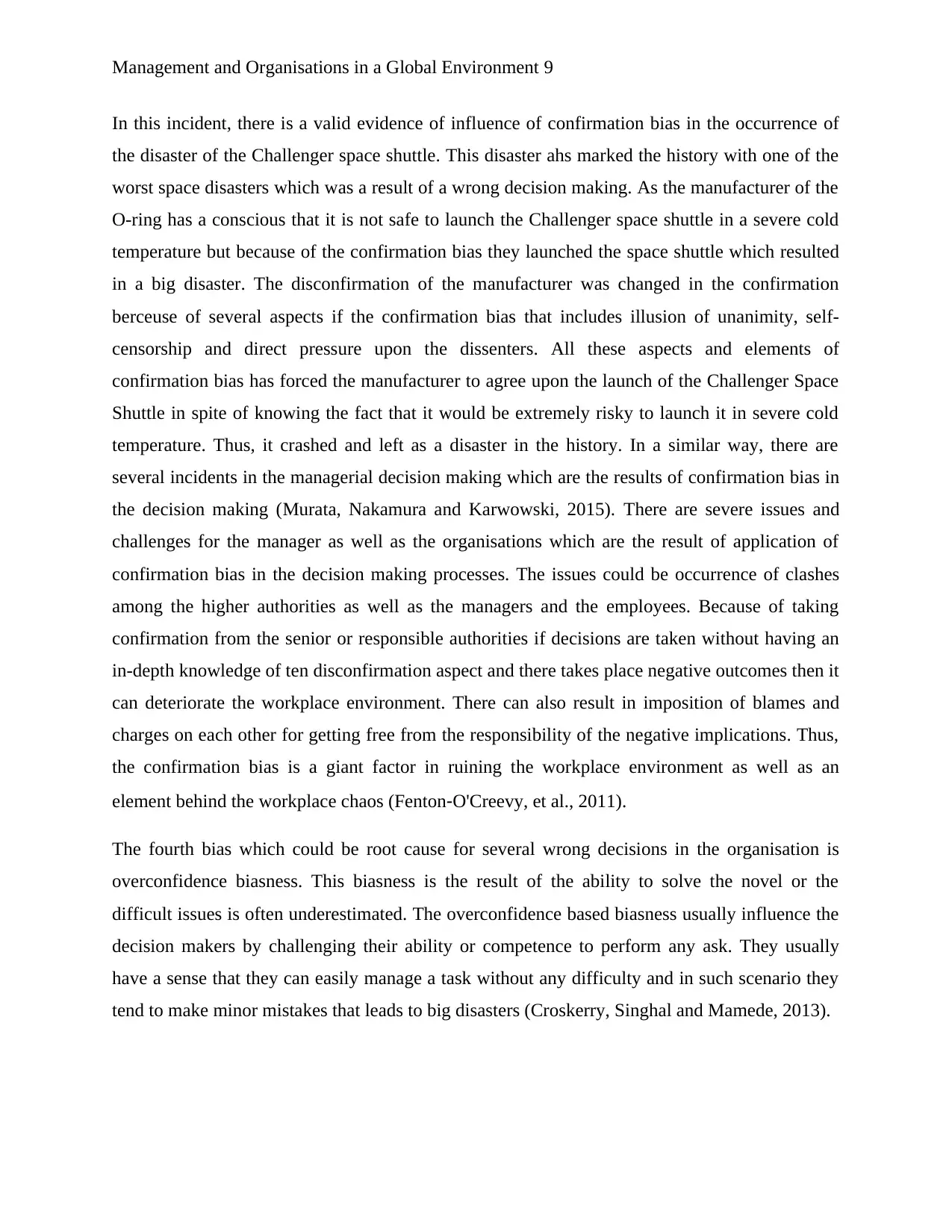
Management and Organisations in a Global Environment 9
In this incident, there is a valid evidence of influence of confirmation bias in the occurrence of
the disaster of the Challenger space shuttle. This disaster ahs marked the history with one of the
worst space disasters which was a result of a wrong decision making. As the manufacturer of the
O-ring has a conscious that it is not safe to launch the Challenger space shuttle in a severe cold
temperature but because of the confirmation bias they launched the space shuttle which resulted
in a big disaster. The disconfirmation of the manufacturer was changed in the confirmation
berceuse of several aspects if the confirmation bias that includes illusion of unanimity, self-
censorship and direct pressure upon the dissenters. All these aspects and elements of
confirmation bias has forced the manufacturer to agree upon the launch of the Challenger Space
Shuttle in spite of knowing the fact that it would be extremely risky to launch it in severe cold
temperature. Thus, it crashed and left as a disaster in the history. In a similar way, there are
several incidents in the managerial decision making which are the results of confirmation bias in
the decision making (Murata, Nakamura and Karwowski, 2015). There are severe issues and
challenges for the manager as well as the organisations which are the result of application of
confirmation bias in the decision making processes. The issues could be occurrence of clashes
among the higher authorities as well as the managers and the employees. Because of taking
confirmation from the senior or responsible authorities if decisions are taken without having an
in-depth knowledge of ten disconfirmation aspect and there takes place negative outcomes then it
can deteriorate the workplace environment. There can also result in imposition of blames and
charges on each other for getting free from the responsibility of the negative implications. Thus,
the confirmation bias is a giant factor in ruining the workplace environment as well as an
element behind the workplace chaos (Fenton‐O'Creevy, et al., 2011).
The fourth bias which could be root cause for several wrong decisions in the organisation is
overconfidence biasness. This biasness is the result of the ability to solve the novel or the
difficult issues is often underestimated. The overconfidence based biasness usually influence the
decision makers by challenging their ability or competence to perform any ask. They usually
have a sense that they can easily manage a task without any difficulty and in such scenario they
tend to make minor mistakes that leads to big disasters (Croskerry, Singhal and Mamede, 2013).
In this incident, there is a valid evidence of influence of confirmation bias in the occurrence of
the disaster of the Challenger space shuttle. This disaster ahs marked the history with one of the
worst space disasters which was a result of a wrong decision making. As the manufacturer of the
O-ring has a conscious that it is not safe to launch the Challenger space shuttle in a severe cold
temperature but because of the confirmation bias they launched the space shuttle which resulted
in a big disaster. The disconfirmation of the manufacturer was changed in the confirmation
berceuse of several aspects if the confirmation bias that includes illusion of unanimity, self-
censorship and direct pressure upon the dissenters. All these aspects and elements of
confirmation bias has forced the manufacturer to agree upon the launch of the Challenger Space
Shuttle in spite of knowing the fact that it would be extremely risky to launch it in severe cold
temperature. Thus, it crashed and left as a disaster in the history. In a similar way, there are
several incidents in the managerial decision making which are the results of confirmation bias in
the decision making (Murata, Nakamura and Karwowski, 2015). There are severe issues and
challenges for the manager as well as the organisations which are the result of application of
confirmation bias in the decision making processes. The issues could be occurrence of clashes
among the higher authorities as well as the managers and the employees. Because of taking
confirmation from the senior or responsible authorities if decisions are taken without having an
in-depth knowledge of ten disconfirmation aspect and there takes place negative outcomes then it
can deteriorate the workplace environment. There can also result in imposition of blames and
charges on each other for getting free from the responsibility of the negative implications. Thus,
the confirmation bias is a giant factor in ruining the workplace environment as well as an
element behind the workplace chaos (Fenton‐O'Creevy, et al., 2011).
The fourth bias which could be root cause for several wrong decisions in the organisation is
overconfidence biasness. This biasness is the result of the ability to solve the novel or the
difficult issues is often underestimated. The overconfidence based biasness usually influence the
decision makers by challenging their ability or competence to perform any ask. They usually
have a sense that they can easily manage a task without any difficulty and in such scenario they
tend to make minor mistakes that leads to big disasters (Croskerry, Singhal and Mamede, 2013).
⊘ This is a preview!⊘
Do you want full access?
Subscribe today to unlock all pages.

Trusted by 1+ million students worldwide
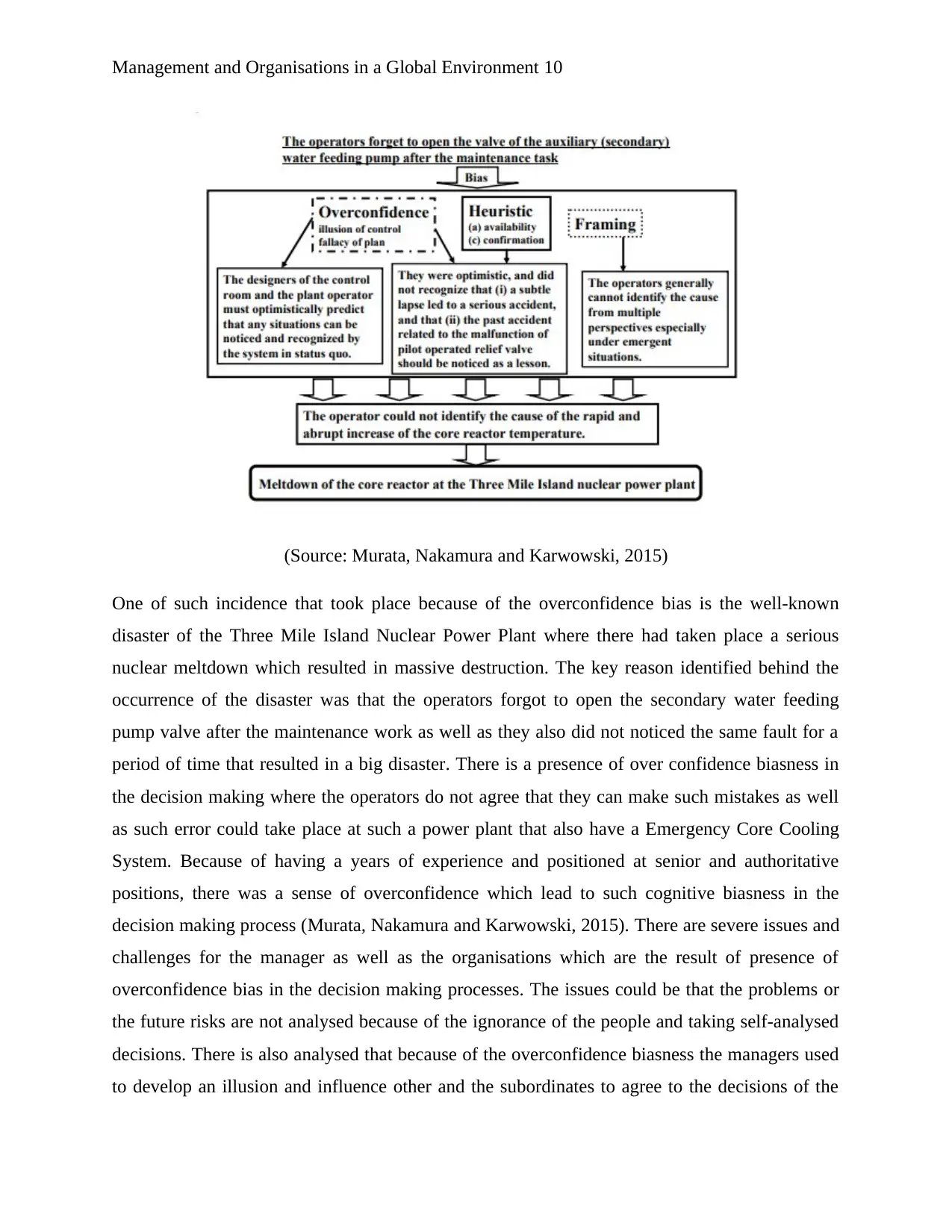
Management and Organisations in a Global Environment 10
(Source: Murata, Nakamura and Karwowski, 2015)
One of such incidence that took place because of the overconfidence bias is the well-known
disaster of the Three Mile Island Nuclear Power Plant where there had taken place a serious
nuclear meltdown which resulted in massive destruction. The key reason identified behind the
occurrence of the disaster was that the operators forgot to open the secondary water feeding
pump valve after the maintenance work as well as they also did not noticed the same fault for a
period of time that resulted in a big disaster. There is a presence of over confidence biasness in
the decision making where the operators do not agree that they can make such mistakes as well
as such error could take place at such a power plant that also have a Emergency Core Cooling
System. Because of having a years of experience and positioned at senior and authoritative
positions, there was a sense of overconfidence which lead to such cognitive biasness in the
decision making process (Murata, Nakamura and Karwowski, 2015). There are severe issues and
challenges for the manager as well as the organisations which are the result of presence of
overconfidence bias in the decision making processes. The issues could be that the problems or
the future risks are not analysed because of the ignorance of the people and taking self-analysed
decisions. There is also analysed that because of the overconfidence biasness the managers used
to develop an illusion and influence other and the subordinates to agree to the decisions of the
(Source: Murata, Nakamura and Karwowski, 2015)
One of such incidence that took place because of the overconfidence bias is the well-known
disaster of the Three Mile Island Nuclear Power Plant where there had taken place a serious
nuclear meltdown which resulted in massive destruction. The key reason identified behind the
occurrence of the disaster was that the operators forgot to open the secondary water feeding
pump valve after the maintenance work as well as they also did not noticed the same fault for a
period of time that resulted in a big disaster. There is a presence of over confidence biasness in
the decision making where the operators do not agree that they can make such mistakes as well
as such error could take place at such a power plant that also have a Emergency Core Cooling
System. Because of having a years of experience and positioned at senior and authoritative
positions, there was a sense of overconfidence which lead to such cognitive biasness in the
decision making process (Murata, Nakamura and Karwowski, 2015). There are severe issues and
challenges for the manager as well as the organisations which are the result of presence of
overconfidence bias in the decision making processes. The issues could be that the problems or
the future risks are not analysed because of the ignorance of the people and taking self-analysed
decisions. There is also analysed that because of the overconfidence biasness the managers used
to develop an illusion and influence other and the subordinates to agree to the decisions of the
Paraphrase This Document
Need a fresh take? Get an instant paraphrase of this document with our AI Paraphraser
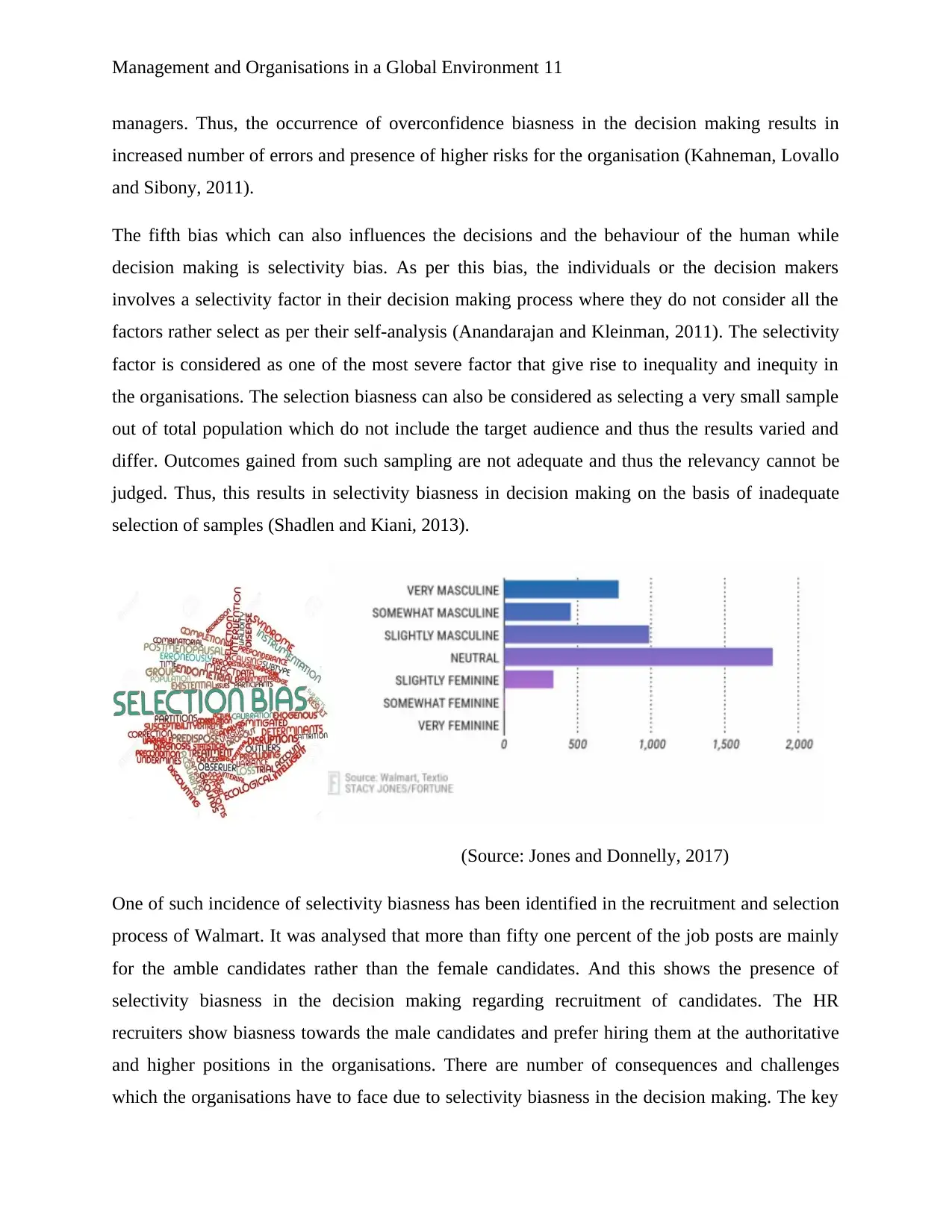
Management and Organisations in a Global Environment 11
managers. Thus, the occurrence of overconfidence biasness in the decision making results in
increased number of errors and presence of higher risks for the organisation (Kahneman, Lovallo
and Sibony, 2011).
The fifth bias which can also influences the decisions and the behaviour of the human while
decision making is selectivity bias. As per this bias, the individuals or the decision makers
involves a selectivity factor in their decision making process where they do not consider all the
factors rather select as per their self-analysis (Anandarajan and Kleinman, 2011). The selectivity
factor is considered as one of the most severe factor that give rise to inequality and inequity in
the organisations. The selection biasness can also be considered as selecting a very small sample
out of total population which do not include the target audience and thus the results varied and
differ. Outcomes gained from such sampling are not adequate and thus the relevancy cannot be
judged. Thus, this results in selectivity biasness in decision making on the basis of inadequate
selection of samples (Shadlen and Kiani, 2013).
(Source: Jones and Donnelly, 2017)
One of such incidence of selectivity biasness has been identified in the recruitment and selection
process of Walmart. It was analysed that more than fifty one percent of the job posts are mainly
for the amble candidates rather than the female candidates. And this shows the presence of
selectivity biasness in the decision making regarding recruitment of candidates. The HR
recruiters show biasness towards the male candidates and prefer hiring them at the authoritative
and higher positions in the organisations. There are number of consequences and challenges
which the organisations have to face due to selectivity biasness in the decision making. The key
managers. Thus, the occurrence of overconfidence biasness in the decision making results in
increased number of errors and presence of higher risks for the organisation (Kahneman, Lovallo
and Sibony, 2011).
The fifth bias which can also influences the decisions and the behaviour of the human while
decision making is selectivity bias. As per this bias, the individuals or the decision makers
involves a selectivity factor in their decision making process where they do not consider all the
factors rather select as per their self-analysis (Anandarajan and Kleinman, 2011). The selectivity
factor is considered as one of the most severe factor that give rise to inequality and inequity in
the organisations. The selection biasness can also be considered as selecting a very small sample
out of total population which do not include the target audience and thus the results varied and
differ. Outcomes gained from such sampling are not adequate and thus the relevancy cannot be
judged. Thus, this results in selectivity biasness in decision making on the basis of inadequate
selection of samples (Shadlen and Kiani, 2013).
(Source: Jones and Donnelly, 2017)
One of such incidence of selectivity biasness has been identified in the recruitment and selection
process of Walmart. It was analysed that more than fifty one percent of the job posts are mainly
for the amble candidates rather than the female candidates. And this shows the presence of
selectivity biasness in the decision making regarding recruitment of candidates. The HR
recruiters show biasness towards the male candidates and prefer hiring them at the authoritative
and higher positions in the organisations. There are number of consequences and challenges
which the organisations have to face due to selectivity biasness in the decision making. The key
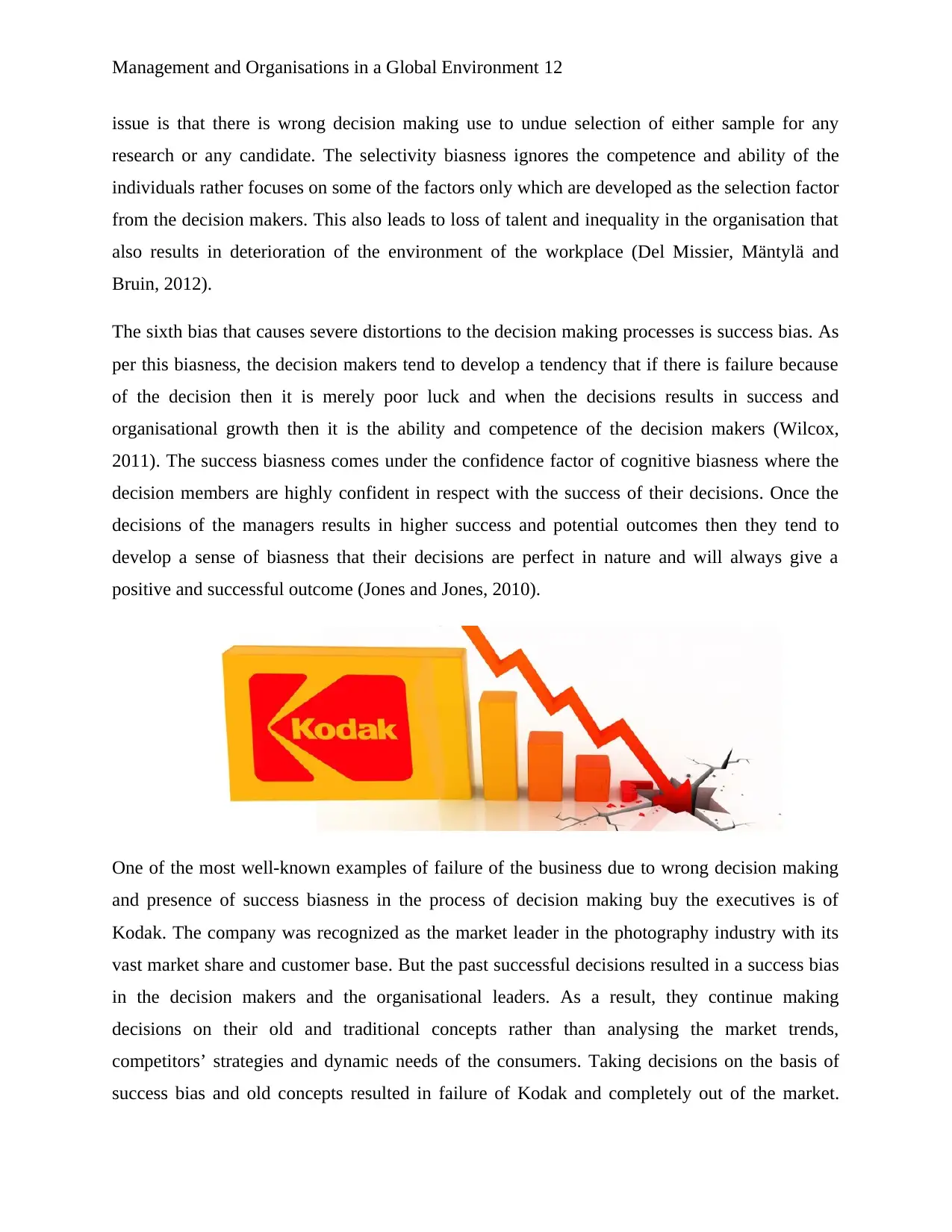
Management and Organisations in a Global Environment 12
issue is that there is wrong decision making use to undue selection of either sample for any
research or any candidate. The selectivity biasness ignores the competence and ability of the
individuals rather focuses on some of the factors only which are developed as the selection factor
from the decision makers. This also leads to loss of talent and inequality in the organisation that
also results in deterioration of the environment of the workplace (Del Missier, Mäntylä and
Bruin, 2012).
The sixth bias that causes severe distortions to the decision making processes is success bias. As
per this biasness, the decision makers tend to develop a tendency that if there is failure because
of the decision then it is merely poor luck and when the decisions results in success and
organisational growth then it is the ability and competence of the decision makers (Wilcox,
2011). The success biasness comes under the confidence factor of cognitive biasness where the
decision members are highly confident in respect with the success of their decisions. Once the
decisions of the managers results in higher success and potential outcomes then they tend to
develop a sense of biasness that their decisions are perfect in nature and will always give a
positive and successful outcome (Jones and Jones, 2010).
One of the most well-known examples of failure of the business due to wrong decision making
and presence of success biasness in the process of decision making buy the executives is of
Kodak. The company was recognized as the market leader in the photography industry with its
vast market share and customer base. But the past successful decisions resulted in a success bias
in the decision makers and the organisational leaders. As a result, they continue making
decisions on their old and traditional concepts rather than analysing the market trends,
competitors’ strategies and dynamic needs of the consumers. Taking decisions on the basis of
success bias and old concepts resulted in failure of Kodak and completely out of the market.
issue is that there is wrong decision making use to undue selection of either sample for any
research or any candidate. The selectivity biasness ignores the competence and ability of the
individuals rather focuses on some of the factors only which are developed as the selection factor
from the decision makers. This also leads to loss of talent and inequality in the organisation that
also results in deterioration of the environment of the workplace (Del Missier, Mäntylä and
Bruin, 2012).
The sixth bias that causes severe distortions to the decision making processes is success bias. As
per this biasness, the decision makers tend to develop a tendency that if there is failure because
of the decision then it is merely poor luck and when the decisions results in success and
organisational growth then it is the ability and competence of the decision makers (Wilcox,
2011). The success biasness comes under the confidence factor of cognitive biasness where the
decision members are highly confident in respect with the success of their decisions. Once the
decisions of the managers results in higher success and potential outcomes then they tend to
develop a sense of biasness that their decisions are perfect in nature and will always give a
positive and successful outcome (Jones and Jones, 2010).
One of the most well-known examples of failure of the business due to wrong decision making
and presence of success biasness in the process of decision making buy the executives is of
Kodak. The company was recognized as the market leader in the photography industry with its
vast market share and customer base. But the past successful decisions resulted in a success bias
in the decision makers and the organisational leaders. As a result, they continue making
decisions on their old and traditional concepts rather than analysing the market trends,
competitors’ strategies and dynamic needs of the consumers. Taking decisions on the basis of
success bias and old concepts resulted in failure of Kodak and completely out of the market.
⊘ This is a preview!⊘
Do you want full access?
Subscribe today to unlock all pages.

Trusted by 1+ million students worldwide
1 out of 19
Related Documents
Your All-in-One AI-Powered Toolkit for Academic Success.
+13062052269
info@desklib.com
Available 24*7 on WhatsApp / Email
![[object Object]](/_next/static/media/star-bottom.7253800d.svg)
Unlock your academic potential
Copyright © 2020–2025 A2Z Services. All Rights Reserved. Developed and managed by ZUCOL.





